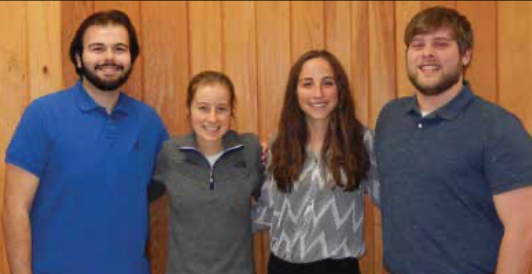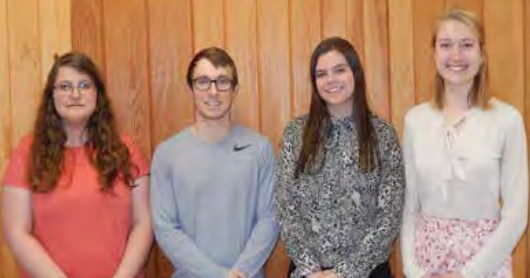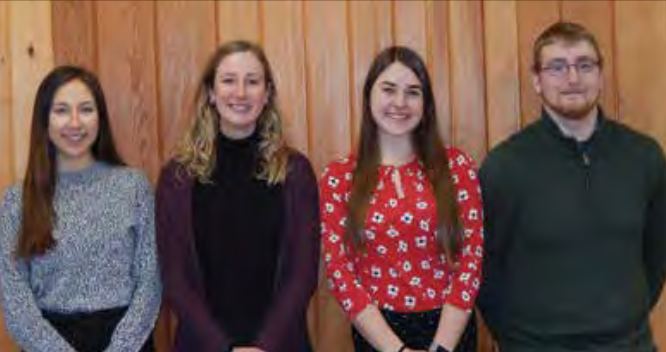Biosystems Engineering student teams, enrolled in the two-semester biosystems design capstone experience, BE 485/487, develop, evaluate, and select design alternatives in order to solve real-world problems. Projects are diverse, but each reflects systems thinking by integrating interconnected issues affecting the problem, including critical biological constraints. The engineering design process is documented in a detailed technical report. Teams present project designs to engineering faculty and a review panel of professional engineers for evaluation. Each BE 485/487 capstone design team prepares and presents a design solution in report, poster and oral formats to an industry advisory board, faculty, peers and the public that:
- Requires engineering design
- Uses a holistic approach
- Combines biology and engineering
- Interprets data
- Solves a real problem
- Evaluates economic feasibility
For information on sponsoring a project, please contact Dr. Dana Kirk or Dr. Luke Reese.
Biosystems Engineering students participate in Spring Term Design Day. The following were the project sponsors and projects for the Spring of 2020:
Ice Cream Inclusion Analysis and Process Optimization
Team Tillamook worked with Tillamook Creamery; a farmer owned dairy co-op located in Oregon. Tillamook is interested in improving their customer satisfaction, specifically related to quantity and distribution of inclusions in their ice cream. Research conducted by the team identified that inclusion distribution was not uniform throughout the ice cream cans. The team identified several design improvements to enhance handling and distribution throughout the manufacturing process. Two solutions, to maintain temperature and improve mixing, were recommended by the team and were tested. These solutions improved inclusion distribution and will help maintain company quality standards for less than 10% of the client’s project budget.
Sponsor – Tillamook Creamery (project under Non-Disclosure Agreement)
Faculty Advisor – Dr. Yan “Susie” Liu
Development of Manufacturing Model for Popped Snacks
Nestlé is looking to expand Gerber Organic Popped Crisps globally. Currently, this product is manufactured in the US by a co-manufacturer. The project scope centered on developing a regional finishing site, where the puffed product is in-house produced, bagged, and sent to a distribution facility. For the preliminary design recommendation, a region was chosen, and equipment was selected based on the needs of the line and the region. The client was provided with a functional piping and instrumentation diagram and an operational description. The design met the client’s payback period constraint, and in-house production reduced supply chain and distribution costs.
Sponsor – Nestlé Nutrition (project under Non-Disclosure Agreement)
Faculty Advisor – Dr. Kirk Dolan
HVAC Energy Efficiency at Pharmaceutical
Manufacturing Plant
 Perrigo is interested in HVAC energy efficiency solutions to reduce energy costs and meet plantwide sustainability goals. SE Solutions researched dew point control and supplemental cooling coils as a customized approach to Perrigo’s current system where the whole plant is controlled to setpoints required in only two suites. The team performed an HVAC energy balance to assess the theoretical impact of these designs and provided complete cost models to Perrigo. Dew point control met the required payback period and the design implementation is completed. SE Solutions analyzed HVAC data to quantify the actual savings realized with this new system.
Perrigo is interested in HVAC energy efficiency solutions to reduce energy costs and meet plantwide sustainability goals. SE Solutions researched dew point control and supplemental cooling coils as a customized approach to Perrigo’s current system where the whole plant is controlled to setpoints required in only two suites. The team performed an HVAC energy balance to assess the theoretical impact of these designs and provided complete cost models to Perrigo. Dew point control met the required payback period and the design implementation is completed. SE Solutions analyzed HVAC data to quantify the actual savings realized with this new system.
Sponsor – Perrigo (project under Non-Disclosure Agreement)
Faculty Advisors – Dr. Chris Saffron
Potato Storage Ventilation Analysis
 Techmark Inc. is an international agricultural company that specializes in stored crop ventilation systems. Techmark designed and implemented an air cup ventilation system in a Greenville, Michigan potato storage facility. The 10,570 ft2 facility has experienced product losses in previous years from improper storage conditions. Important system characteristics hypothesized to be involved in product loss were the following air properties: temperature, humidity, and overall airflow distribution in the storage room. CFD analysis and data collected served as tools to determine condensation possibility within the air cup. A data collection plan was created for further analysis with potatoes present.
Techmark Inc. is an international agricultural company that specializes in stored crop ventilation systems. Techmark designed and implemented an air cup ventilation system in a Greenville, Michigan potato storage facility. The 10,570 ft2 facility has experienced product losses in previous years from improper storage conditions. Important system characteristics hypothesized to be involved in product loss were the following air properties: temperature, humidity, and overall airflow distribution in the storage room. CFD analysis and data collected served as tools to determine condensation possibility within the air cup. A data collection plan was created for further analysis with potatoes present.
Sponsor – Techmark, Inc.
Faculty Advisor – Dr. Wei Liao, PE
Operational Analysis of Trident
Biometrics’ Drug Testing Process
 Trident Biometrics, a drug testing laboratory in Holland, Michigan, specializes in urine testing. Trident needed to optimize their process to handle an expected sample volume doubling while maintaining their promised 48-hour results turnaround time. Based on time study data collected by the team, a Work Breakdown Structure and Gantt Chart were created in Microsoft Project to identify the critical pathway. The critical path determined five tasks that directly affected testing time and was used to identify resource limitations. To increase sample throughput, the team recommended labor and equipment solutions and rearranged methods on machines, which optimized testing time and reduced risk of bottlenecks.
Trident Biometrics, a drug testing laboratory in Holland, Michigan, specializes in urine testing. Trident needed to optimize their process to handle an expected sample volume doubling while maintaining their promised 48-hour results turnaround time. Based on time study data collected by the team, a Work Breakdown Structure and Gantt Chart were created in Microsoft Project to identify the critical pathway. The critical path determined five tasks that directly affected testing time and was used to identify resource limitations. To increase sample throughput, the team recommended labor and equipment solutions and rearranged methods on machines, which optimized testing time and reduced risk of bottlenecks.
Sponsor – Trident Biometrics (project under Non-Disclosure Agreement)
Faculty Advisor – Dr. Jade Mitchell
Simulation of Thermal Energy Transfer through Neurological Tissue
during Electrosurgery
 Electrosurgery has many medical applications, one of which involves the use of radiofrequency technology to resect tumorous brain tissue. Stryker is interested in simulating the transfer of thermal energy from an electrosurgical instrument in a synthetic tissue model to characterize the propagation of heat through actual brain tissue. Team Phantom evaluated two materials that mimic the thermal and physical properties of the human brain to accurately quantify heat dissipation during electrosurgery. The team evaluated a polyacrylamide gel containing bovine serum albumin (BSA) protein and an evaporated milk agar, and then compared these to pig brain tissue results to make a final model recommendation.
Electrosurgery has many medical applications, one of which involves the use of radiofrequency technology to resect tumorous brain tissue. Stryker is interested in simulating the transfer of thermal energy from an electrosurgical instrument in a synthetic tissue model to characterize the propagation of heat through actual brain tissue. Team Phantom evaluated two materials that mimic the thermal and physical properties of the human brain to accurately quantify heat dissipation during electrosurgery. The team evaluated a polyacrylamide gel containing bovine serum albumin (BSA) protein and an evaporated milk agar, and then compared these to pig brain tissue results to make a final model recommendation.
Sponsor – Stryker (project under Non-Disclosure Agreement)
Faculty Advisor – Dr. Ilce Medina Meza
Blake’s Hard Cider Apple Pomace Utilization and Optimization
 Blake’s Hard Cider Company located in Armada, Michigan, was looking for an opportunity to reduce apple pomace by-product, which they now land apply as a soil amendment. Through research and experimentation, the team determined that an enzymatic pretreatment of the apple mash before pressing is the best method to reduce apple pomace. Enzymatic pretreatment breaks down long-chained sugar molecules before pressing, increasing juice yield up to 30%. With a simple one-step addition to their production process, Blake’s has the potential to reduce apple pomace by 72% and increase profits.
Blake’s Hard Cider Company located in Armada, Michigan, was looking for an opportunity to reduce apple pomace by-product, which they now land apply as a soil amendment. Through research and experimentation, the team determined that an enzymatic pretreatment of the apple mash before pressing is the best method to reduce apple pomace. Enzymatic pretreatment breaks down long-chained sugar molecules before pressing, increasing juice yield up to 30%. With a simple one-step addition to their production process, Blake’s has the potential to reduce apple pomace by 72% and increase profits.
Sponsor – Blake’s Hard Cider Co.
Faculty Advisor – Dr. Brad Marks, PE
Determining Equipment and Utility
Recommendations for a Food Business
Accelerator
 The Food, Agriculture, Research, and Manufacturing Business Incubator is being built in Muskegon, Michigan, to provide a facility for food businesses to test and produce products, establish brands, and grow their businesses. To accomplish this goal, Team Food ACCELS designed six processing lines accommodating fruit, vegetable, and beverage products. The team recommended equipment
The Food, Agriculture, Research, and Manufacturing Business Incubator is being built in Muskegon, Michigan, to provide a facility for food businesses to test and produce products, establish brands, and grow their businesses. To accomplish this goal, Team Food ACCELS designed six processing lines accommodating fruit, vegetable, and beverage products. The team recommended equipment
and utility requirements necessary to produce the selected products at a rate of up to 40 gpm. These deliverables assisted in purchasing ancillary equipment within the $200,000 budget, applying for grants, determining rental rates, and configuring the facility with necessary utilities including electricity, water, air, and steam.
(L to R) Rosemary Laurito, Peter Jansen, Leah Allen & Scott Piper
Sponsor – Food, Agriculture, Research, and Manufacturing
Business Incubator
Faculty Advisor – Dr. Darrell Donahue, CQE
Wastewater Optimization for Cost Efficiency
 Our client, a large food manufacturer, pretreats their wastewater before
Our client, a large food manufacturer, pretreats their wastewater before
sending it away for further treatment. Wastewater must be pretreated properly before discharge to abide by permit regulations and not negatively impact the environment. This company was looking for an opportunity to minimize the overall cost but still properly treat the wastewater. WasteWatchers discussed nine design alternatives to address the opportunity. After research and an economic analysis, managing the residual product was deemed the best solution. Areas of focus for this solution were how to properly treat and handle the residual product and possible post-treatment utilization options.
Sponsor – Large Food Manufacturer (project under
Non-Disclosure Agreement)
Faculty Advisors – Dr. Steve Safferman, PE
Pawpaw Fruit Skin Removal Improvement
 Pawpaws are a relatively unknown North American fruit native to lower Michigan. Their taste is often described as a tropical mango-banana blend. Pawpaws must tree ripen, have a very thin skin, and damage easily in transport thus making them difficult to market fresh. Treeborn creates a puree with the pawpaw pulp which requires complete skin removal prior to processing. Skin removal must be efficient as skin remnants
Pawpaws are a relatively unknown North American fruit native to lower Michigan. Their taste is often described as a tropical mango-banana blend. Pawpaws must tree ripen, have a very thin skin, and damage easily in transport thus making them difficult to market fresh. Treeborn creates a puree with the pawpaw pulp which requires complete skin removal prior to processing. Skin removal must be efficient as skin remnants
in the pulp and the resulting oxidation after peeling can cause puree off-flavor and color. Treeborn uses a labor and time intensive manual skin removal process. The selected design provides an appropriate-scale solution that improves skin removal efficiency, reduces processing time and labor, and increases pulp yield.
Sponsor – Treeborn
Faculty Advisors – Dr. Dan Guyer
Tuberculosis Diagnosis using
Artificial Intelligence
 In Nepal, Tuberculosis (TB) affects nearly 32,000 individuals annually, resulting in around 7,000 deaths. Team AIM was challenged with creating a cost-effective and accurate TB diagnostic tool. The new diagnostic method removes human error and improves detection accuracy using an Android smartphone application. The application utilizes Artificial Intelligence (AI) in combination with the Nanoparticle-based Colorimetric Biosensing Assay (NCBA) test method to rapidly diagnose TB. The team anticipates that this new method’s accuracy will exceed 83% and result in an efficient and affordable diagnosis for Nepalis. The implementation of AI to TB detection will create rapid diagnosis for individuals to begin treatment, overall decreasing the spread of TB in affected areas.
In Nepal, Tuberculosis (TB) affects nearly 32,000 individuals annually, resulting in around 7,000 deaths. Team AIM was challenged with creating a cost-effective and accurate TB diagnostic tool. The new diagnostic method removes human error and improves detection accuracy using an Android smartphone application. The application utilizes Artificial Intelligence (AI) in combination with the Nanoparticle-based Colorimetric Biosensing Assay (NCBA) test method to rapidly diagnose TB. The team anticipates that this new method’s accuracy will exceed 83% and result in an efficient and affordable diagnosis for Nepalis. The implementation of AI to TB detection will create rapid diagnosis for individuals to begin treatment, overall decreasing the spread of TB in affected areas.
Sponsor – Dr. Nirajan Bhusal
Faculty Advisor – Dr. Evangelyn Alocilja











